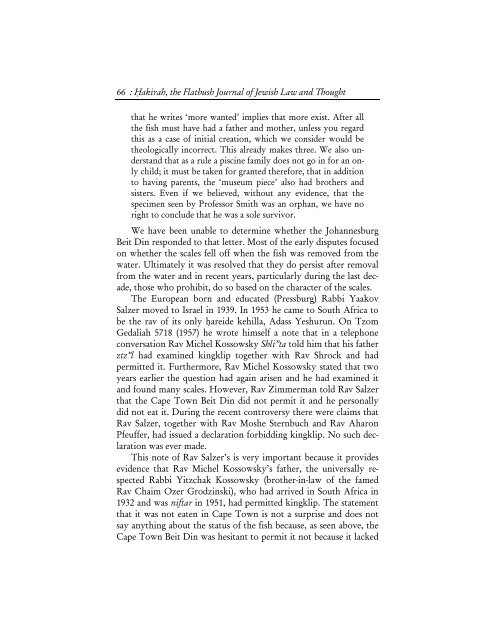The Kashrut of Kingklip: Its Turbulent History and Who ... - Hakirah
The Kashrut of Kingklip: Its Turbulent History and Who ... - Hakirah
The Kashrut of Kingklip: Its Turbulent History and Who ... - Hakirah
You also want an ePaper? Increase the reach of your titles
YUMPU automatically turns print PDFs into web optimized ePapers that Google loves.
66 : Hạkirah, the Flatbush Journal <strong>of</strong> Jewish Law <strong>and</strong> Thought<br />
that he writes ‘more wanted’ implies that more exist. After all<br />
the fish must have had a father <strong>and</strong> mother, unless you regard<br />
this as a case <strong>of</strong> initial creation, which we consider would be<br />
theologically incorrect. This already makes three. We also underst<strong>and</strong><br />
that as a rule a piscine family does not go in for an only<br />
child; it must be taken for granted therefore, that in addition<br />
to having parents, the ‘museum piece’ also had brothers <strong>and</strong><br />
sisters. Even if we believed, without any evidence, that the<br />
specimen seen by Pr<strong>of</strong>essor Smith was an orphan, we have no<br />
right to conclude that he was a sole survivor.<br />
We have been unable to determine whether the Johannesburg<br />
Beit Din responded to that letter. Most <strong>of</strong> the early disputes focused<br />
on whether the scales fell <strong>of</strong>f when the fish was removed from the<br />
water. Ultimately it was resolved that they do persist after removal<br />
from the water <strong>and</strong> in recent years, particularly during the last decade,<br />
those who prohibit, do so based on the character <strong>of</strong> the scales.<br />
<strong>The</strong> European born <strong>and</strong> educated (Pressburg) Rabbi Yaakov<br />
Salzer moved to Israel in 1939. In 1953 he came to South Africa to<br />
be the rav <strong>of</strong> its only hareide kehilla, Adass Yeshurun. On Tzom<br />
Gedaliah 5718 (1957) he wrote himself a note that in a telephone<br />
conversation Rav Michel Kossowsky Shli”ta told him that his father<br />
ztz”l had examined kingklip together with Rav Shrock <strong>and</strong> had<br />
permitted it. Furthermore, Rav Michel Kossowsky stated that two<br />
years earlier the question had again arisen <strong>and</strong> he had examined it<br />
<strong>and</strong> found many scales. However, Rav Zimmerman told Rav Salzer<br />
that the Cape Town Beit Din did not permit it <strong>and</strong> he personally<br />
did not eat it. During the recent controversy there were claims that<br />
Rav Salzer, together with Rav Moshe Sternbuch <strong>and</strong> Rav Aharon<br />
Pfeuffer, had issued a declaration forbidding kingklip. No such declaration<br />
was ever made.<br />
This note <strong>of</strong> Rav Salzer’s is very important because it provides<br />
evidence that Rav Michel Kossowsky’s father, the universally respected<br />
Rabbi Yitzchak Kossowsky (brother-in-law <strong>of</strong> the famed<br />
Rav Chaim Ozer Grodzinski), who had arrived in South Africa in<br />
1932 <strong>and</strong> was niftar in 1951, had permitted kingklip. <strong>The</strong> statement<br />
that it was not eaten in Cape Town is not a surprise <strong>and</strong> does not<br />
say anything about the status <strong>of</strong> the fish because, as seen above, the<br />
Cape Town Beit Din was hesitant to permit it not because it lacked
















